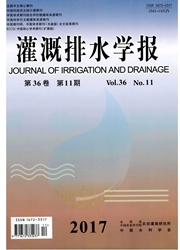

 中文摘要:
中文摘要:
采用室内人工降雨模拟试验,分析了小降雨强度下聚丙烯酰胺(PAM)对埃土和砂黄土坡面土壤水分养分迁移过程的影响。试验结果表明,与对照相比较,PAM处理降低坡地入渗速率,增大了地表径流量,砂黄土表现更显著,其径流系数提高了约113%;PAM对土壤硝态氮流失过程影响甚微,但对径流磷和钾的流失特征影响显著;施加PAM分别增加凄土坡地径流磷和径流钾流失量近55%和100%,分别提高了砂黄土坡地径流磷和径流钾流失量1.4倍和4.8倍。因此,水蚀环境不严重的黄土坡地,采用地表施加PAM方式来降低土壤养分流失的途径是不适宜的。
 英文摘要:
英文摘要:
By the method of artificial rainfall simulated experiments, the influences of polyacrylamide (PAM) on the transportation processes of soil water and nutrients were conducted on the sloped loess land with clay loam soil and sandy soil at light rainfall. Results show that, as compared with check experiments, PAM use decreased the infiltration rate, and increased the surface runoff. In particular, PAM treatment had great improvement of surface runoff for the sloped land with sandy soil, and it 's runoff coef- ficient had been enlarged by 113%. PAM had little effect on the NO3^--N loss process, however signifi- cantly affected variability of PO4^3- and K^+ concentrations in runoff with time. PAM treatment increased the losses of PO4^3-and K^+ in runoff by about 55% and 100% for clay loam soil , and by about 1.4 times and 4.8 times for sandy soil, respectively. So it is not'feasible method for applying PAM to decrease nutrients losses in runoff on loess sloped land under little water erosion conditions.
 同期刊论文项目
同期刊论文项目
 同项目期刊论文
同项目期刊论文
 期刊信息
期刊信息
